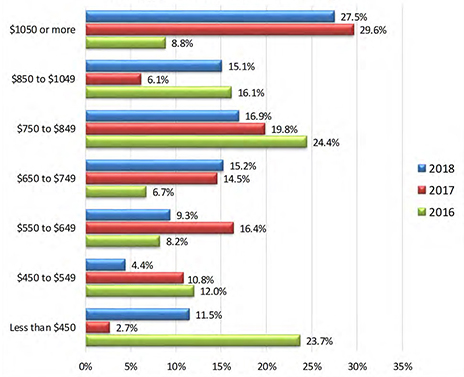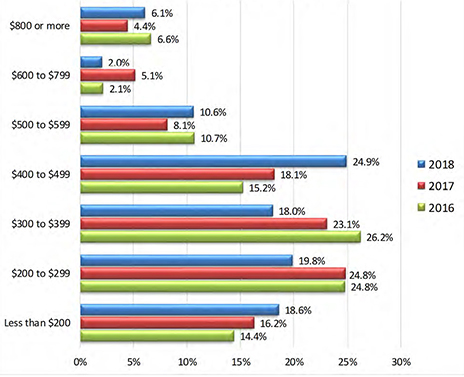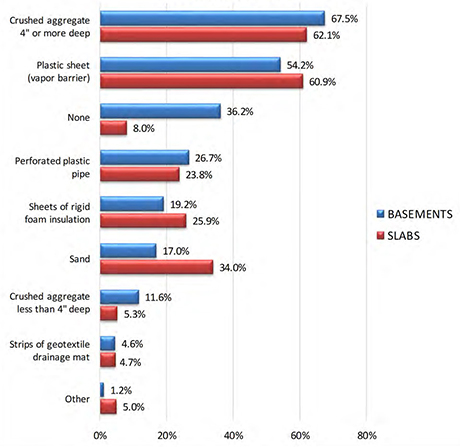Tommy Bowles, Office of Radiation and Indoor Air, US EPA
Every year Home Innovation Research Labs (HIRL) performs the Annual Builder Practices Survey (ABPS), a nationally disseminated building practices survey. The survey is mailed to over 53,000 active U.S. home building companies, of various size and capacity, nationwide to gather data on new home construction practices and materials selection. HIRL then provides a comprehensive breakdown based on the data obtained from the ABPS in what they call Builder Practice Reports. One of those reports, The Radon-Resistant Construction Practices in New US Homes Report, is prepared for the U.S. Environmental Protection Agency (EPA) by HIRL. In order to obtain radon-specific data, the EPA purchased questions to insert into the ABPS and learn what builders are doing about radon.
The report provides an accurate depiction of the new construction housing stock built during a specific calendar year. The data and analysis in this article pertain only to 2018 single family-detached (SFD) and multifamily dwellings. (The 2019 report will be available in fall 2020)
In 2018, an estimated 750,625 single-family detached and 498,708 multifamily dwellings were built in the United States.
Summary of Radon in New Construction in 2018
To be considered a radon-reduction system for this study, a house must have either a passive stack ventilation pipe or an active (fan-driven) system. In 2018, the percentage of all new SFD homes – excluding those on piers – with a radon-reduction system was 20.2%. This is slightly down from 21.7% in 2017 but still higher than 2016’s 18.7%, consistent with the overall upward trend of increased usage of radon-resistant practices. Passive stack depressurization systems were reported for 16.9% of SFD, while active systems accounted for 3.2%. Some 39.5% of SFD homes with basements had radon-reducing features, which compares to 21.7% for crawlspace foundations and 5.6% slab on grade.
Some builders are opting to perform lower-cost rough-ins which only involve sub-slab preparation and installation of a stubbed vent pipe above the slab to allow for low-cost venting of the sub-slab area if post-construction testing finds a radon problem. In 2018, rough-ins for radon-reducing systems were found in 7.3% of the SFD homes, compared to 5.0% in 2017 and 5.6% in 2016.
In multifamily dwellings, 33.8% of all new dwellings installed radon-reducing features, up from 26.6% in 2017 and 19% in 2016. Overall, thanks in large part to multifamily, there was an upward trend of new U.S. homes with radon-reducing features. The breakdown of radon-reducing features by Radon Potential Zones determined in EPA’s 1993 Map of Radon Zones by U.S County was also considered. SFD homes with radon-reducing features increased in both Zones 1 and 2 but decreased in Zone 3. In 2018, the number of new SFD homes built with radon-reducing features was 77,300 (or 45.1% of all SFD) in Zone 1, 76,300 (or 31.7 %) in Zone 2, and 10,500 (or 3.2%) in Zone 3. This is comparable to the 2017 results where shares of SFD homes with radon-reducing features in Zones 1, 2, and 3 were 44.9%, 26%, and 9.2% respectively.
For multifamily, the share of units in 2018, with radon reducing features in Zone 1 was 112,900 (or 92.5%); 41,500 (or 27.2%) in Zone 2; and 89,900 in Zone 3. This represents an increase in Zones 1 and 3 and a decrease in Zone 2 from 2017’s numbers, where the shares of units for Zones 1,2, and 3 were 77.9%, 76.3%, and 1.2% respectively.
Cost
The cost of installing radon‐reducing systems has been on the rise in recent years. In 2018, the average installation cost for a passive system in a single‐family detached home was approximately $377, up slightly from the $367 reported for 2017 and $374 reported for 2016.
Figure 1. Cost of Active Sub-Slab Ventilation in Single-Family Detached Homes, 2016 to 2018

The average cost of an active (fan-driven) radon‐reduction system in new single‐family detached homes in 2018 was $812, higher than the $808 reported for 2017 and $697 for 2016.
Figure 2 Cost of Passive Sub-Slab Ventilation in Single-Family Detached Homes, 2016 to 2018

In 2018, the average reported installation cost per unit for a passive system in a multifamily dwelling was approximately $393, down from the $461 in 2017 and $417 in 2016.
The average per-unit cost of an active radon‐reduction system reported in new multifamily dwellings in 2018 was $845, lower than $865 in 2017, but higher than $757 in 2016.
The study also provides other key indices of radon reduction that can be more closely examined, such as radon-related building practices like sub-slab preparation and foundation sealing methods, and installation costs.
Sealing Methods
Builders are reporting using a plastic or other vapor barrier in applications not necessarily related to radon gas reduction in 60.9 % of homes in 2018, 72.4 % in 2017, and 70.6 % in 2016.
Sub-slab Preparation
Four or more inches of gravel or stone base is standard construction practice for drainage purposes in many areas of the country, making the incremental cost of a full radon-resistant system significantly lower. In the figure below, you can see the different methods utilized or not utilized for prepping underneath the slab or basement.
Figure 3. Sub-slab Preparation: Basements or Slabs, 2018


